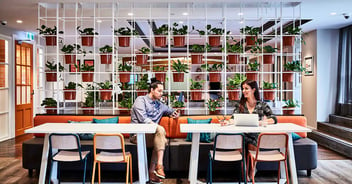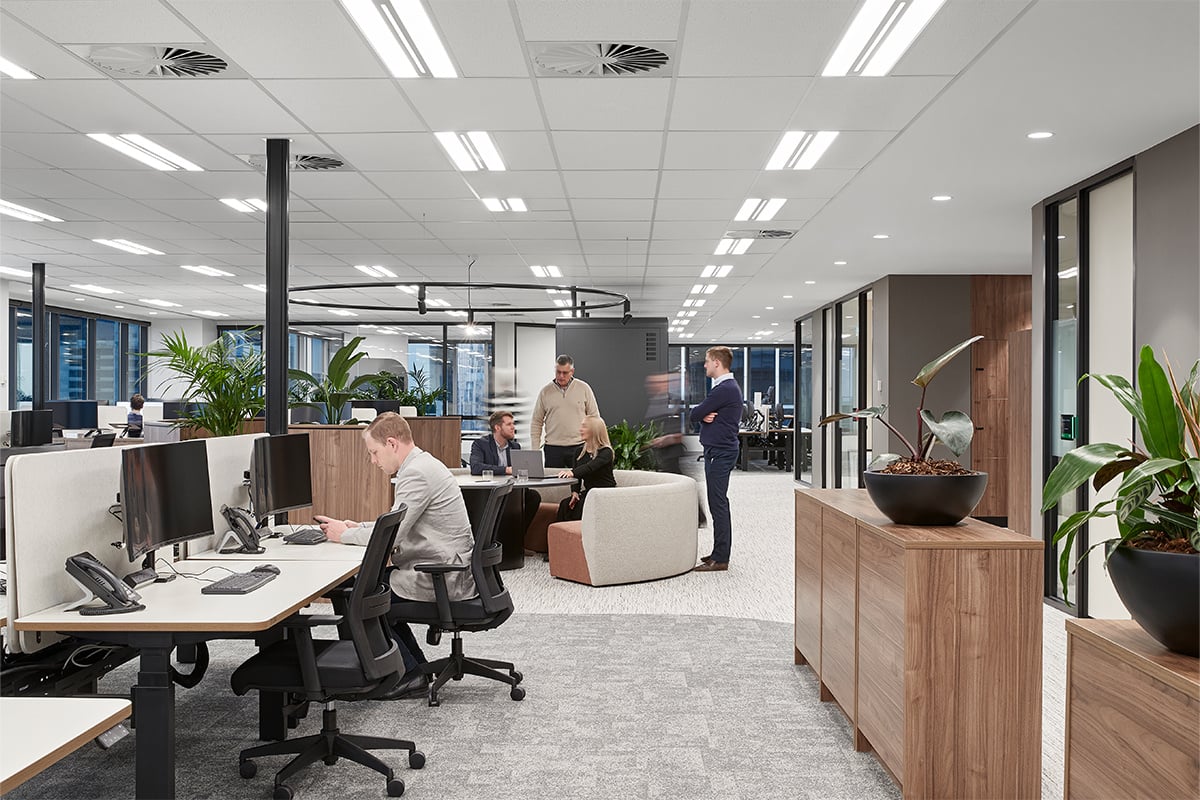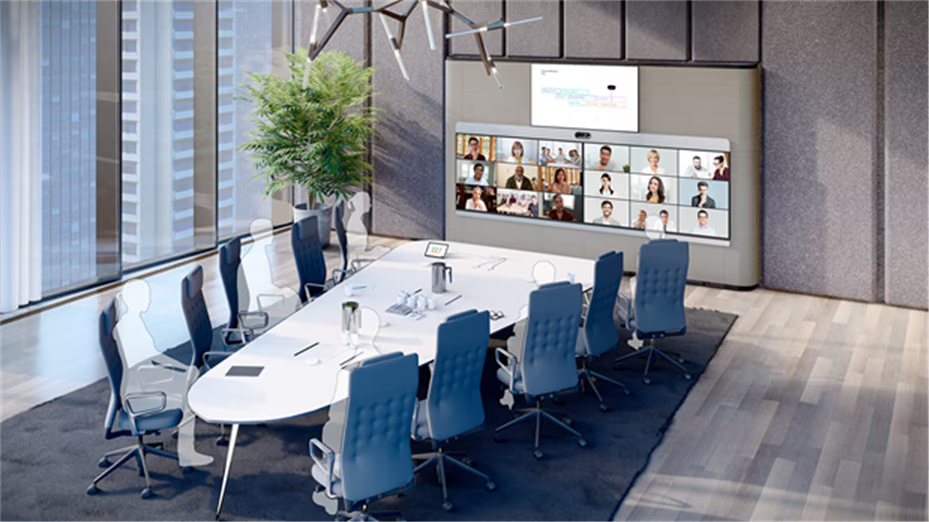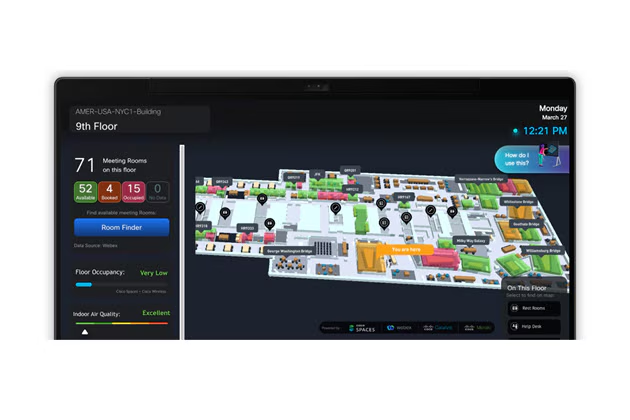
Building happier, healthier, more productive workplaces through technology

The way we work has changed significantly over the past couple of years – and there’s no going back. Here’s how technology can help your organisation support the workforce of the future.
A new, hybrid way of working is having a profound impact on the role of workspaces.
“Today the workplace acts more as a connector,” says Dean Rikanovic, Workplace Interior Architect at Axiom Workplaces. “It needs to enable people to engage, exchange, share, learn. To connect with culture and the brand.”
Offices that can do this well will support hybrid work, foster social connections and enhance performance through technology – and create a happier, more productive workforce.
Technology Enables Hybrid Work.
Hybrid working is here to stay. In Australia over a third (37%) of employees are working from home regularly and 74% of knowledge workers want a mixed arrangement of remote and in-office work.
While employees expect hybrid arrangements to stay, most feel positive about going back to the office a few days per week – as long as it looks and functions differently to how it used to.
More than half of employees say their office is not where it needs to be to enable them to do their best work.
"“In a hybrid environment, supporting people to feel and do their best requires organisations to look at the intersectionality between people, physical space and technology." Anthony Collins, Lead Advisor, Cisco
Technology plays a key role in responding to the needs of a hybrid workforce. It can enable collaboration and connection, and support people to do their job well, no matter where they are.
Video conferencing and digital content sharing tools and systems like Cisco’s Room Panorama, can bring people together – whether they’re across the table or across the globe.
For individuals, collaboration workstations can allow people working remotely to connect with anyone seamlessly and without distraction. Built-in AI features like background noise removal and voice activations help employees focus, while real-time translation, interactive whiteboards and intuitive interfaces allow them to collaborate without limitations.
Security is also critical for hybrid work arrangements. Implementing unified cyber security that extends from your office to every person connecting to your network helps mitigate risks and give your people secure access from anywhere.
Equitable, seamless access and experiences are key to supporting a happy and productive hybrid workforce – and technology is a key enabler.
“Organisations need to think about technology as being ubiquitous. Whether your people are in the office or at home, they need to have the same, consistent technology experience,” says Collins.
Improve Wellbeing by Fostering Social Connections.
The desire for more social interactions is the reason 68% of APAC employees are keen to return to the office.
It’s not surprising, as relationships significantly influence people’s health and happiness. The world’s longest study into happiness has found that the impact of loneliness on our health is as powerful as smoking or alcoholism.
And this extends to our life at work. The study uncovered that what people miss most about work when they stop isn’t the work itself, but workplace relationships.
Designing workspaces that foster bonds and encourage social interactions is critical in enhancing wellbeing, especially in a hybrid environment.
Rikanovic says, "Organisations need to think about how they can create an environment where people feel safe and empowered to come together, have conversations and feel connected. We're seeing more open, soft lounge spaces that encourage social interaction. Many organisations are starting to use food and beverage to connect people with each other, offering international menus and trying different cuisines on a set day of the week.”

This feeds into office layout and design as well.
Only a decade ago, workplace design was more conventional – from a reception area to back of house workstations and a cafeteria or kitchen at the back. Rikanovic says this is no longer the case.
“Office spaces today take people on an organic journey. The cafe is more front and centre, and you don't have a reception desk – it's more of a mobile post. You then move into a space that's filled with different meeting rooms and booths and open, collaborative environments.”
Organisations are also getting creative with how they keep remote workers connected. Nokia, for example, created a virtual café for its employees. Anyone can pop onto the platform and connect socially with other Nokia staff from around the world. Others use UberEats or food packages to make sure people working from home have the same experience as those in the office.
Team chat applications with channels or group chats also help build rhythm and rituals into people’s days.
“Our employee resource organisations (EROs), like the Cisco Disability Action Network, have dedicated spaces on WebEx, where people can connect and share stories, information and set up events. These spaces help break down physical and cultural barriers, and give everybody in the company a voice.”
Technology Enhancing Performance and Social Connectivity
Both employers and employees see the growth of hybrid arrangements as an opportunity to create more productive, enriching and inclusive workplaces.
But organisations need to take a step back to make sure they get this right, says Rikanovic.
“You need to start by defining what productivity means to your business and how you can create the environments to boost it.”
Setting clear goals is equally important, adds Collins.
“Identify what you’re trying to achieve, then structure the budget around that. Think about three core areas: your people’s needs, the physical space and what the technology should look like based on your goals.”
For example, to improve onboarding, some organisations are using digital twins. Using the existing 4D model that was created as part of the workspace design process, employees can visit the office virtually before their first day as a gamified experience. Organisations can also use the model to monitor and optimise building performance.
Some employers may be interested in technology that can help them support a diverse workforce. They may consider investing in background noise removal, noise cancelling headsets and AI meeting summaries to help neurodiverse employees block out distractions and focus. Live translations can also help break down language barriers, while screen readers and voice to text or live closed captions can support people with disabilities.
Technology such as Cisco Spaces also allows workplaces to map the entire office environment – from which meeting rooms are booked and what workspace occupancy looks like to what the ambient noise is within different office areas. This helps employees choose the right space for their needs and preferences while allowing organisations to continually optimise the environment.
“The ‘ghost’ function in our meeting room booking technology monitors the occupancy levels in rooms and makes meeting spaces available if there are no shows,” shares Collins. “We also know that higher CO2 in the air can make people feel a little drowsy. Technology can monitor CO2 levels in meeting rooms and automatically feed back to the facilities management system to counteract it – helping people stay more alert and engaged during meetings.”
Elevate Your Office Space Through Tech
Finding the perfect balance between human and digital, and in-person and remote can be challenging. But it offers a rare opportunity to transform the modern workplace, put people first and create more productive, connected and healthier environments.
At Axiom, we continue to help organisations elevate their workplaces through data-driven, evidence-based methodologies. And by working with industry-leading partners like Cisco to integrate technology into modern office spaces, we help your business thrive and your people flourish.
Find out more about the role of workplace strategy for digital transformation, download the ebook below:







